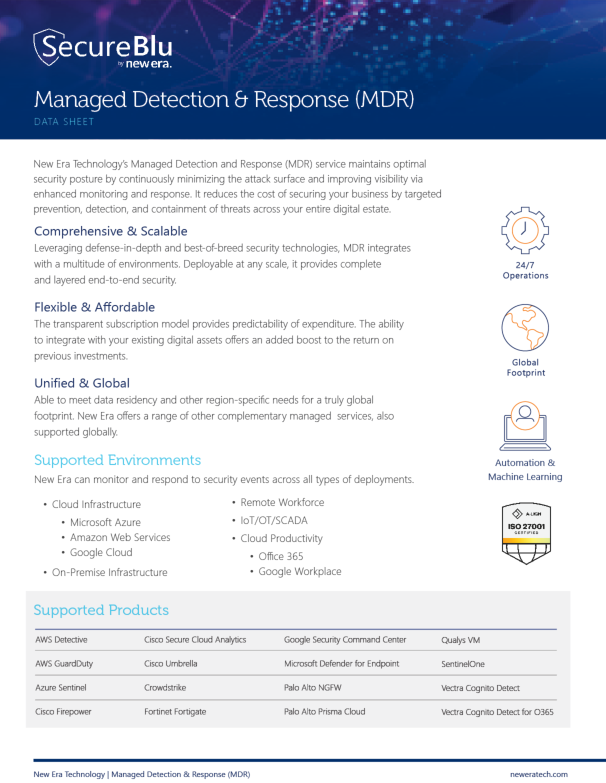Managed Detection & Response (MDR) Services
Preventing, Detecting, & Containing Threats
New Era Technology’s Managed Detection and Response (MDR) service maintains optimal security posture by continuously minimizing the attack surface and improving visibility via enhanced monitoring and response. It reduces the cost of securing your business by targeted prevention, detection, and containment of threats across your entire digital estate.
Cloud Infrastructure Monitoring & Response
On-Premise Infrastructure Monitoring & Response
Cloud Productivity Monitoring & Response
Remote Workforce Monitoring & Response
IoT/OT/SCADA Monitoring & Response
Physical Security & Life Safety Monitoring
Schedule a Time With a Security Expert
Your time is valuable! Schedule a whiteboard session to collaborate, brainstorm and create a security roadmap personalized to your security needs.
Key Features of New Era’s MDR Solution
Threat Detection and Response Delivered by Security Experts
New Era’s Managed Detection and Response solution follows secure design principles. Together we find ways to minimize the attack surface, create a zero-trust environment, develop processes to segregate data per customer, and ensure the MDR solution is highly flexible to meet your needs.
24/7 Operations
With continuous vigilance, we reduce the disruption of business in the event of an incident.
Global Footprint
Source your security with a single provider to reduce the cost and complexity.
Customer Portal
Improve decision-making with real-time visibility of ongoing and historical security evetns, incidents, and responses.
Automation & Machine Learning
Our MDR service is always learning to provide rapide and accurate responses.
Threat & Vulnerability Intelligence
High-level of accuracy in identifying security threats and incidents.
ISO27001 Accreditation
New Era’s security team conforms to information standards.
What environments does New Era’s MDR support?
New Era Technology can monitor and respond to security events across all types of deployments.
- Cloud Infrastructure
- On-premise Infrastructure
- Remote Workforce
- IoT/OT/SCADA
- Cloud Productivity
Recommended Security Resources
Your Top Cyber Security Questions Answered by New Era Security Experts
There are always questions when it comes to complex topics such as security. We have pulled together the top questions we hear from clients to help start the conversation. If you think of additional questions, please reach out. The Security team enjoys talking about anything security.
What is MDR?
Managed Detection and Response (MDR) provides ongoing log and threat monitoring, alert triage and analysis, and incident response. MDR services incorporate various technologies such as SIEM, EDR, and threat intelligence tools while also performing proactive threat hunting. Each alert is essential, telling a story such as a precursor or indication of a cyberattack. As a result, MDR can reduce threat detection and response time.
What are some benefits of MDR?
MDR compliments and fills many gaps within enterprise security posture, such as providing skilled and experienced Security Analysts and eyes-on-glass monitoring and visibility and reducing costs and mean times to detect and respond to security incidents. Read an in-depth article on choosing an MDR Provider here.
How to choose the best MDR Provider?
Choosing an MDR provider is a complex decision. The MDR service must fit your financial budget, align with business goals and security strategies, and effectively detect threats and reduce risk. In addition, you will be interfacing with the SOC Analysts supporting the MDR service; they must add value and positively complement your security team. Read in in-depth article here.
Prevent, Detect, and Contain Threats
New Era’s Managed Detection and Response (MDR) solution eliminates alert fatigue and false positives to promote a faster response based on your security needs.
Our MDR solution meets data residency and other region-specific needs, ensuring that we can assist customers worldwide.


New Era’s Portfolio
The SecureBlu portfolio of security services will cover all your security needs regardless of your organization’s size or industry. Our Security Advisory Services offers vulnerability assessments, compliance, penetration testing, deployment, and integration services. We also support your infrastructure with managed firewalls, DNS security, multi-factor authentication, and managed SIEM.

 Canada
Canada Australia
Australia New Zealand
New Zealand UAE
UAE United Kingdom
United Kingdom